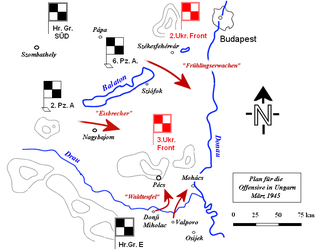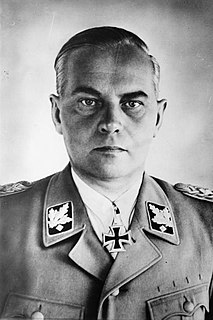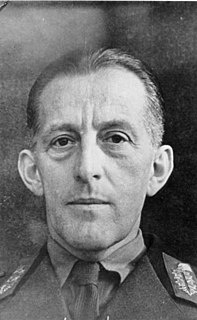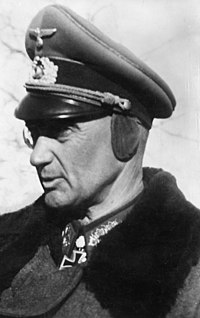
Operation Barbarossa also known as the German invasion of the Soviet Union was the code name for the invasion of the Soviet Union by Nazi Germany and some of its Axis allies, which started on Sunday, 22 June 1941, during World War II. The operation put into action Nazi Germany's ideological goal of conquering the western Soviet Union so as to repopulate it with Germans. The German Generalplan Ost aimed to use some of the conquered people as slave labour for the Axis war effort while acquiring the oil reserves of the Caucasus as well as the agricultural resources of various Soviet territories. Their ultimate goal included the eventual extermination, enslavement, Germanization and mass deportation to Siberia of the Slavic peoples, and to create more Lebensraum for Germany.

Heinz Wilhelm Guderian was a German general during World War II who, after the war, became a successful memoirist. An early pioneer and advocate of the "blitzkrieg" approach, he played a central role in the development of the panzer division concept. In 1936, he became the Inspector of Motorized Troops.

Hermann Hoth was a German army commander and war criminal during World War II. He fought in the Battle of France and as a panzer commander on the Eastern Front. Hoth commanded the 3rd Panzer Group during Operation Barbarossa in 1941, and the 4th Panzer Army during the Wehrmacht's 1942 summer offensive.

The Eastern Front of World War II was a theatre of conflict between the European Axis powers against the Soviet Union (USSR), Poland and other Allies, which encompassed Central Europe, Eastern Europe, Northeast Europe (Baltics), and Southeast Europe (Balkans) from 22 June 1941 to 9 May 1945. It was known as the Great Patriotic War in the Soviet Union and some of its successor states, while everywhere else it was called the Eastern Front.

The Battle of Moscow was a military campaign that consisted of two periods of strategically significant fighting on a 600 km (370 mi) sector of the Eastern Front during World War II. It took place between October 1941 and January 1942. The Soviet defensive effort frustrated Hitler's attack on Moscow, the capital and largest city of the Soviet Union. Moscow was one of the primary military and political objectives for Axis forces in their invasion of the Soviet Union.

Paul Ludwig Ewald von Kleist was a German field marshal during World War II. Kleist was the commander of Panzer Group Kleist, the first operational formation of several Panzer corps in the Wehrmacht during the Battle of France, the Battle of Belgium, the Invasion of Yugoslavia and Operation Barbarossa, the invasion of the Soviet Union.

Operation Spring Awakening was the last major German offensive of World War II. The operation was referred to in Germany as the Plattensee offensive and in the Soviet Union as the Balaton defensive operation. It took place in Western Hungary on the Eastern Front and lasted from March 6 until March 15, 1945. The objective was to secure the last significant oil reserves still available to the European Axis powers and prevent the Red Army from advancing towards Vienna. It was a failure for Nazi Germany.

Felix Martin Julius Steiner was a German SS commander during the Nazi era. During World War II, he served in the Waffen-SS, the combat branch of the SS, and commanded several SS divisions and corps. He was awarded the Knight's Cross of the Iron Cross with Oak Leaves and Swords. Together with Paul Hausser, he contributed significantly to the development and transformation of the Waffen-SS into a combat force made up of volunteers and conscripts from both occupied and un-occupied lands.

Helmuth Otto Ludwig Weidling was a German general during World War II. He was the last commander of the Berlin Defence Area during the Battle of Berlin, and led the defence of the city against Soviet forces, finally surrendering just before the end of World War II in Europe.

Gotthard Fedor August Heinrici was a German general during World War II. Heinrici is considered as the premier defensive expert of the Wehrmacht. His final command was Army Group Vistula, formed from the remnants of Army Group A and Army Group Center to defend Berlin from the Soviet armies advancing from the Vistula River.

Operation Saturn, revised as Operation Little Saturn, was a Red Army operation on the Eastern Front of World War II that led to battles in the North Caucasus and Donets Basin regions of the Soviet Union from December 1942 to February 1943.
The 1st Panzer Army was a German tank army that was a large armoured formation of the Wehrmacht during World War II.
The 3rd Panzer Division was an armoured division in the German Army, the Wehrmacht, during World War II.
Kenneth John Macksey was a British author and historian who specialized in military history and military biography, particularly of the Second World War. Macksey was commissioned in the Royal Armoured Corps and served during the Second World War. Macksey later wrote a biography of Hobart. Macksey gained a permanent commission in 1946, was transferred to the Royal Tank Regiment in 1947, reached the rank of major in 1957 and retired from the Army in 1968.

Wilhelm Josef Ritter von Thoma was a German army officer who served in World War I, in the Spanish Civil War, and as a general in World War II. He was a recipient of the Knight's Cross of the Iron Cross.

Georg-Hans Reinhardt was a German general and war criminal during World War II. He commanded the 3rd Panzer Army from 1941 to 1944, and Army Group Centre in 1944 and 1945, reaching the rank of colonel general (Generaloberst).

The East Pomeranian strategic offensive operation was an offensive by the Soviet Red Army against the German Wehrmacht on the Eastern Front. It took place in Pomerania and West Prussia from 10 February – 4 April 1945.

Otto Moritz Walter Model was a German field marshal during World War II. Although he was a hard-driving, aggressive panzer commander early in the war, Model became best known as a practitioner of defensive warfare. His relative success as commander of the Ninth Army in the battles of 1941–1942 determined his future career path. He has been called the Third Reich's best defensive tactical commander.

The Myth of the Eastern Front: The Nazi–Soviet War in American Popular Culture is a 2008 book by the American historians Ronald Smelser and Edward J. Davies of the University of Utah. It discusses perceptions of the Eastern Front of World War II in the United States in the context of historical revisionism. The book traces the foundation of the post-war myth of the "Clean Wehrmacht", its support by US military officials, and the impact of Wehrmacht and Waffen-SS mythology on American popular culture, up to the time of its publication.
Samuel W. Mitcham Jr. is an American writer of military history who specializes in the German war effort during World War II. He is the author of more than 40 books and has been criticized for neo-Confederate views and a forgiving view of Nazi Germany.















